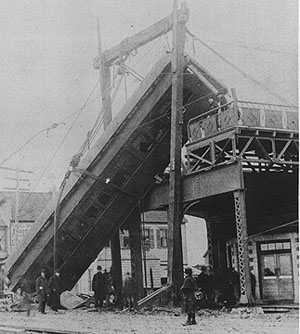
|
On December 23, 1895, a
motorcar crashed right through the bumping post onto 48th
Avenue when the motorman fell asleep at the throttle. A
wrecking crew is trying to hoist the car back onto the
tracks. The station can be seen on the right, under the
tracks. The brick and stone building is typical of many Met
stations. (Photo from the
Bruce G. Moffat Collection)
|
Cicero
(4800W/600S)
Cicero Avenue and Harrison
Street, Austin
Service
Notes:

|
Garfield
Line
|
Quick Facts:
Address: 615 S. Cicero Avenue
Established: June 19, 1895
Original Line: Metropolitan West Side Elevated, Garfield
Park branch
Previous Names: 48th Avenue
|
Skip-Stop Type:
|

|
Station
|
Rebuilt: n/a
Status: Demolished
History:
In 1892, the Metropolitan West Side Elevated Railroad planned a
main line west from Franklin to
Marshfield, where three branches went
northwest to Milwaukee and Austin (the Logan
Square line), with a branch to 72nd Avenue and North (the
Humboldt Park line);
southwest to 46th Avenue and 21st Street (the Douglas
Park line); and due west to 48th Avenue at the city limits (the
Garfield Park line).
Only the Garfield
Park initially reached its goal (and only the Douglas
Park also reached its under the Metropolitan Elevated banner). By
August 1893, the Garfield
Park branch's steel was in place from Paulina to Sacramento and
from Kedzie to Douglas Boulevard and by May 15, 1894, it was almost
totally complete. Despite being one of the first lines finished, the
Garfield Park didn't
open until June 19, 1895, going all the way to its 48th Avenue
terminal.
The station house was typical of the Met designs on the Northwest
and Garfield Park
branches. Constructed of red pressed brick with stone sills and
foundations, their vernacular style might best be described as Queen
Anne-influenced with some Romanesque features. The stations' original
design was highlighted by a semicircular bay/portico, a lattice
pattern in the brick cornice, extensive terra cotta work including
the word "entrance" above one door in the portico and "exit" above
the other, dentals above the doors' story lights, and carved wooden
beads flush with the building between the wooden brackets which
support a wooden canopy over the portico.
The station's dual side platforms had canopies and railings
typical of all Met stations: Designed into the railings were larger
cast iron square plates with a stylized diamond design. The stairs
and platforms were constructed of wood on a steel structure. Each
platform had a short canopy in the center of the platform, covering
the stairs and a small waiting area. The canopy frame was iron, with
arched latticed supports and bracketed rafters, and hipped roofs of
corrugated tin. The station was constructed such that it would be
simple to extend it father west. The tracks simply ended at a bumping
post at the end of the platforms. This would eventually lead to a
significant problem....
On December 25, 1895, the Metropolitan "L" recorded a dubious
first for the elevated. As a westbound train neared the terminal, the
motorman fell asleep. The car coasted right past the platform and
flew right through the bumping post and off the elevated tracks to
the street below. The car rested against the street and tracks at a
45û angle and, miraculously, the motorman, conductor and their lone
passenger escaped with only minor bruises. It took the Met almost two
days to hoist the car back onto the tracks. Some blamed the use of
straight air brakes instead of automatic air brakes,which would apply
in just such a predicament. (The brakes were later converted.)
In June 1900, the Chicago City Council authorized an extension of
the Garfield Park
branch of the Metropolitan Elevated Railroad to 52nd
from 48th Avenue. Work was delayed when a land owner refused to sell
his parcel, which unfortunately was across the street from the 48th
Avenue terminal. Not wishing to delay, the Met simply built around
it, with the tracks descending to the ground on a 1,200-foot ramp.
Eventually, the property owner sold and while most railroads would
then have to operate around a nonexistent obstruction, the Met has
build the ramp so it could be moved. In mid-July, 1902, it was
reported that occasional service was being run to 52nd
Avenue, with 48th becoming a through station.
The Chicago
Aurora & Elgin interurban used the Garfield
Park branch to reach downtown Chicago through a reciprocal
trackage rights agreement from February 23, 1905 to September 20,
1953. For most of that time the CA&E didn't serve Cicero station,
but on December 9, 1951 the interurban began stopping at Cicero and
discontinued stopping at Laramie
concurrent with their resumption of local service to stations in
Maywood and Bellwood.
In the mid-1950s, work was undertaken to replace the Garfield
Line with a new rapid transit line in the median of the Congress
Expressway, parallel to a roughly a block from the Garfield
Line. Cicero remained open throughout the highway construction
project. The station was closed in 1958 when the replacement
Congress Line opened
a block north. A replacement station entrance -- the Cicero entrance
to Cicero station -- was opened on
the Congress
Line.
By August 1959, the station house and lower section of the stairs to the platforms had been removed. That month, the Chicago Transit Board awarded a $106,646 contract to Lipsett Steel Products, Inc. to demolish the remaining stairs, platforms, canopies, railings, flooring, cross girders, columns, brackets and stringers at Cicero and five other closed Garfield
Park stations, as well as the elevated structure between Sacramento Blvd. and Lavergne Avenue.
.



